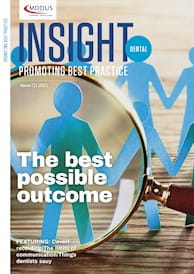"THE single biggest problem in communication is the illusion that it has taken place.” These words, attributed to George Bernard Shaw, describe the situation where both sides of a conversation believe they understand what has been passed between them, but the ideas they have are not the same. This is where the illusion of communication can be most damaging.
One of my biggest lightbulb moments about patient communication occurred a couple of years after I moved to Ireland. Although my work routinely took me into dental practices there and in the UK, I needed to find myself a new dentist with whom I could build rapport and who was not a client.
Like many dentists, I was not in the habit of regular attendance and knew that some repair was overdue. The initial consultation with the chosen professional was great. They were pleasant, thorough and clearly had a gentle touch. Radiographs and photographs were taken and displayed on the ceiling-mounted screens. I had no doubts about the diagnosis and the suggested treatment plan. So far, so very good.
I booked my next appointment. The front desk people were lovely; they did and said all the right things. I left happy in my choice of practice and team and I still am. The only slight problem was that by the time I reached my car I had no idea which side of my mouth was to be treated and whether upper, lower or both jaws were to be involved. A dental degree, 30-odd years of telling, showing and then checking with patients that they understood meant nothing.
A dental chair is an intimidating and disorientating place and one’s focus as a patient is easily distracted. I called the practice and within 24 hours my treatment proposal arrived via email. It was easy for me to understand and I remembered what was planned.
We have all had that experience to a certain extent, whether with a sales person, a builder, lawyer, gardener or even a surgeon, where we want to appear to understand and don’t want to seem dim. When someone takes time to explain things to us we feel better about the person and trust them more, even if we don’t necessarily comprehend fully.
Lessons learned
Never presume. My new dentist may well have thought – with my dental background, and my apparent understanding – that all was clear. But when you are in an unfamiliar place or position, things just don’t look the same.
Give information up front. I grasped early in my career not to sugar coat the treatment planned. It was best to ensure that the patient understood what would be involved. If they are going to be in your chair for two hours, tell them. If they can expect to be sore and swollen, say so. If they are expected to tolerate temporary restorations for some weeks, let them know. Having to allow a patient to get out of the chair half way through a visit to feed a parking meter does nothing for equanimity. Sharing information with patients ahead of time is preparation, telling them afterwards is an excuse.
Understand the limits. Everyone has different learning and communication styles and it’s useful to be aware of these. There is a lot of research out there on this topic for those interested in further reading. Notable contributions in the field have been made by Honey and Mumford, whose work describes the activist, reflector, theorist and pragmatist learning preferences. Much has also been written on the Visual-Auditory-Kinaesthetic (VAK) learning style model. Similar to our self-estimation of driving skills, we all tend to think that we are better communicators than we are. An acknowledgment that your style of communication may not suit every patient, every time, is vital, so flexibility is of great importance.
Use technology well. Ironically, some of the advances in technology designed to help communication can make things worse if poorly used. A dentist probably sees hundreds or thousands of radiographs before interpretation becomes second nature; expecting a patient to see and understand a lesion might be setting the bar too high. Clinical photographs and models are not familiar day-to-day sights to patients.
Delegate well. There is a trend to delegate many elements of communication to care co-ordinators or other team members. Ideally, this has the advantage of conversations taking place in a non-clinical setting, but it is vital that the team member is trained to seek and answer concerns. Delegation must not lead to abdication.
Avoid jargon. Verbal and bodily communications are amongst the vital soft skills that benefit from regular examination, practice and revision. In every practice manual there should be a dictionary of technical words, phrases and acronyms to be avoided and the straightforward, clear and unambiguous words and metaphors to be used in their place. The regular honest discussion of what has gone well, or not, and why, tests the system and provides a basis for revisions. For me, the mantra is: “Just because you have said it and even written it, does not mean the patient has understood it.”
Alun K Rees is an experienced dental practice owner who works as a coach, consultant, troubleshooter, analyst, speaker, writer and broadcaster. Find out more at www.dentalbusinesscoach.co.uk
This page was correct at the time of publication. Any guidance is intended as general guidance for members only. If you are a member and need specific advice relating to your own circumstances, please contact one of our advisers.
Read more from this issue of Insight Dental

Save this article
Save this article to a list of favourite articles which members can access in their account.
Save to library